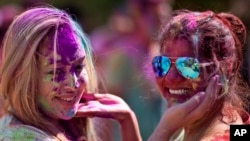Hundred of devotees in northern India's holy city of Mathura rejoiced over the Hindu festival of colors, 'Holi', on Sunday, as they gathered in large numbers at the mythical birth place of Lord Krishna.
Though 'Holi' is a single-day affair elsewhere in India, it is almost a 10-day festival across several parts of Uttar Pradesh province.
Men and women alike daubed each other in powdered colors and danced around the streets in merriment.
A tourist, Neha Sharma, said it was a special experience to witness 'Holi' in Mathura, which Hindu mythology denotes as the birthplace of Lord Krishna.
"I would like to say that we feel really good. In order to surrender to the love of Lord Krishna [Hindu God], people from within the country and abroad come here to watch colorful Holi," said Sharma.
Priests at the 'Nand Bhawan' (residing place of Lord Krishna) sprayed water from water guns made of silver and gold.
Thousands of devotees and tourists from across the world throng Mathura during 'Holi' every year to revel in the festivities.
"I haven't seen such Holi in my life. It is a beautiful Holi and I think this cannot happen anywhere in the world. We really missed this and have especially come from Canada to witness this Holi," said a tourist, Avinash Sharma.
It is believed that Lord Krishna leaves his residing place and comes out to the courtyard to play 'Holi' with devotees during this day.
Celebrated at the onset of spring, 'Holi' also holds a mythological importance - that of the triumph of good over evil. It is also associated with the eternal love of Lord Krishna and his consort Radha.
It is the most awaited festival among the Hindus, especially among the youth. People of all ages forget mutual differences and smear powdered colors on each other.
Security tight at Pakistan celebrations
In Pakistan's port city of Karachi, around 400 local Hindus gathered in the Swami Narayan Mandir, one of the city's Hindu temples, to playfully splash colors on one another.
Non-Muslims make up only about three percent of the 190 million population of Muslim-majority Pakistan.
"The Holi festival is basically the biggest festival of the Hindu community. During this festival people visit each other's houses, distribute sweets, and greet their friends. In the evening, people get together in one place to worship and daub colors on one another," said a Hindu doctor Pardeep Kumar. "The purpose of sprinkling colors is to paint the entire society in one color so that the differences in the society can be brought to an end."
Security was exceptionally tight around all Hindu temples across the country, and worshippers had to undergo a thorough search before they entered venues of the festival.
Holi, perhaps the least religious of Hindu festivals, is widely recognized for the throwing and applying of colored water and powders on friends and family, which gives the holiday its common name "Festival of Colors."
Holi is primarily observed in India, Nepal, and Sri Lanka but also in countries with large Hindu populations such as Suriname, Malaysia, Guyana, South Africa, United States, Mauritius, and Fiji.










